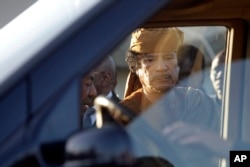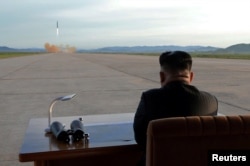United States President Donald Trump said, “We’ll have to see,” when asked if a planned meeting with North Korea’s leader will take place.
On Wednesday, North Korea threatened to cancel the meeting between Trump and Kim Jong Un in Singapore on June 12. It said North Korea is not interested in “one-sided” negotiations only meant to cause the North to give up its nuclear weapons.
North Korea’s Vice Foreign Minister Kim Kye Kwan released the statement on the state-run KCNA news agency.
He also criticized comments from U.S. National Security Advisor John Bolton. In April, Bolton called for the North to give up its nuclear and missile weapons like Libya. He told Fox News, "We have very much in mind the Libya model.”
The U.S. removed sanctions on Libya in exchange for a promise to give up its nuclear program in 2003. Eight years later, Libya’s leader Moammar Gadhafi was overthrown and killed by rebels. That was shortly before Kim Jong Un became North Korea’s leader.
On Wednesday, U.S. Secretary of State Mike Pompeo spoke to South Korean Foreign Minister Kang Kyung-hwa. He told Kang that the U.S. continues to prepare for the meeting.
Pompeo met with Kim Jong Un recently to discuss issues including the planned meeting with Trump. On Sunday, Pompeo said that the U.S. would lift sanctions on North Korea if it agreed to completely end its nuclear program.
Kim Dong-yub is a North Korea expert at Seoul’s Institute for Far Eastern Studies. He told the Associated Press the North is not trying to undermine the Trump-Kim talks. The North’s reaction, he said, is more like a “complaint over Trump’s way of playing the good cop and bad cop game with Pompeo and Bolton.”
Others wonder whether the North’s latest comments are an effort to negotiate from a stronger position. After all, North Korea has had a long history of withdrawing from agreements on its nuclear and missile activities.
A short history of North Korea’s nuclear negotiations
In 1991, the United States announced that it would remove its nuclear weapons from South Korea as part of an arms reduction treaty with the Soviet Union.
The following year, North and South Korea agreed to ban nuclear weapons or efforts to develop them. The nations said they would seek nuclear energy only for peaceful purposes.
In 1993, North Korea rejected international nuclear inspectors and said it might withdraw from the Nuclear Nonproliferation Treaty. As a result, former U.S. President Jimmy Carter visited North Korea which then promised to freeze its nuclear program in 1994. But, later that year, North Korean leader Kim Il-sung died and his son, Kim Jong Il took power.
In 1999, North Korea suspended testing long-distance missiles in exchange for an easing of some sanctions put in place by the U.S.
Then came a period of good feeling in which high-level North Korean officials met with U.S. and South Korean officials.
The feeling, however, began to change when President George W. Bush accused North Korea of being part of “an axis of evil” in 2001. The following year, North Korea admitted that it had a secret uranium enrichment program. In 2003, the North withdrew from the Nuclear Nonproliferation Treaty.
Later that year, the Six Party Talks became an effort by all nations in the area to deal with the North Korean nuclear issue. The group included the two Koreas, China, Japan, Russia and the U.S. Tension, however, increased as North Korea tested its first nuclear weapon in 2006.
The Six Party talks also broke down in 2008 and have not been restarted since then. Officials could not reach agreement on methods to prove the North was carrying out its requirements to end its nuclear program.
In 2011, Kim Jong Un became North Korea’s leader after the death of his father, Kim Jong Il. North Korea agreed to suspend its nuclear activities in exchange for aid. But the deal ended with North Korea’s test of a long-distance rocket.
U.S. efforts at diplomacy entered a period of what has been called “strategic patience.” Under this policy, the U.S. and its partners have increased sanctions on North Korea in an effort to get it to return to negotiations.
During this period, however, North Korea has carried out four nuclear tests including one in 2017 which, the North claims, was a hydrogen bomb.
In addition to its nuclear tests, North Korea has tested long-distance missiles with ever-increasing range over the last two years.
With the most recent launch last fall, North Korea tested a missile said to be able to reach all of the continental U.S.
I’m Mario Ritter.
Mario Ritter adapted this story for VOA Learning English with materials from VOA, AP, Reuters and the Council on Foreign Relations. Hai Do was the editor.
_____________________________________________________________
Words in This Story
sanctions –n. actions taken against a country to cause it to obey international law usually by restricting trade
undermine –v. to make something or someone weaker or less effective
complaint –n. a statement showing unhappiness or dissatisfaction
Nonproliferation –n. activities aimed at keeping the numbers of something from increasing
enrichment –n. the process of improving the quality of something such as the purity of a mineral
strategic –adj. related to a long term plan
range –n. a specific distance, a distance that something can travel
We want to hear from you. Write to us in the Comments section, and visit our Facebook page.














